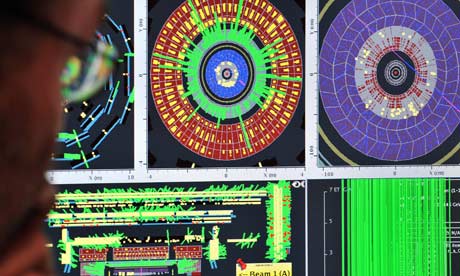 Two exciting races tracked through Grenoble, France this passed week. First, the Tour de France held one of the definitive stages of the 2011 race in Grenoble, the individual time trial. Second, Grenoble hosted the European Physical Society conference on High-Energy Physics. Fans of professional cycling and high energy physics would not be disappointed.
Two exciting races tracked through Grenoble, France this passed week. First, the Tour de France held one of the definitive stages of the 2011 race in Grenoble, the individual time trial. Second, Grenoble hosted the European Physical Society conference on High-Energy Physics. Fans of professional cycling and high energy physics would not be disappointed.
In cycling, Cadel Evans set a blistering pace in his solo effort on stage 20 to ensure the Yellow Jersey and an overall win in this year’s Tour.
In the world of high energy physics, physicists from Fermilab and CERN presented updates on their competing searches to discover (or not) the Higgs boson. The two main experiments at Fermilab, CDF and DZero, are looking for traces of the Higgs particle in the debris of Tevatron collider’s proton-antiproton collisions. At CERN’s Large Hadron Collider scientists working at the two massive detectors, Atlas and CMS, are sifting through vast mountains of data accumulated from proton-proton collisions.
 Both colliders have been smashing particles together in their ongoing quest to refine our understanding of the building blocks of matter, and to determine the existence of the Higgs particle. The Higgs is believed to convey mass to other particles, and remains one of the remaining undiscovered components of the Standard Model of physics.
Both colliders have been smashing particles together in their ongoing quest to refine our understanding of the building blocks of matter, and to determine the existence of the Higgs particle. The Higgs is believed to convey mass to other particles, and remains one of the remaining undiscovered components of the Standard Model of physics.
The latest results presented in Grenoble show excess particle events, above a chance distribution, across the search range where the Higgs particle is predicted to be found. There is a surplus of unusual events at a mass of 140-145 GeV (gigaelectronvolts), which is at the low end of the range allowed for the particle. Tantalizingly, physicists’ theories predict that this is the most likely region where the Higgs is to be found.
[div class=attrib]Further details from Symmetry Breaking:[end-div]
Physicists could be on their way to discovering the Higgs boson, if it exists, by next year. Scientists in two experiments at the Large Hadron Collider pleasantly surprised attendees at the European Physical Society conference this afternoon by both showing small hints of what could be the prized particle in the same area.
“This is what we expect to find on the road to the Higgs,” said Gigi Rolandi, physics coordinator for the CMS experiment.
Both experiments found excesses in the 130-150 GeV mass region. But the excesses did not have enough statistical significance to count as evidence of the Higgs.
If the Higgs really is lurking in this region, it is still in reach of experiments at Fermilab’s Tevatron. Although the accelerator will shut down for good at the end of September, Fermilab’s CDF and DZero experiments will continue to collect data up until that point and to improve their analyses.
“This should give us the sensitivity to make a new statement about the 114-180 mass range,” said Rob Roser, CDF spokesperson. Read more about the differences between Higgs searches at the Tevatron and at the LHC here.
The CDF and DZero experiments announced expanded exclusions in the search for their specialty, the low-mass Higgs, this morning. On Wednesday, the two experiments will announce their combined Higgs results.
Scientists measure statistical significance in units called sigma, written as the Greek letter ?. These high-energy experiments usually require 3? level of confidence, about 99.7 percent certainty, to claim they’ve seen evidence of something. They need 5? to claim a discovery. The ATLAS experiment reported excesses at confidence levels between 2 and 2.8?, and the CMS experiment found similar excesses at close to 3?.
After the two experiments combine their results — a mathematical process much more arduous than simple addition — they could find themselves on new ground. They hope to do this in the next few months, at the latest by the winter conferences, said Kyle Cranmer, an assistant professor at New York University who presented the results for the ATLAS collaboration.
“The fact that these two experiments with different issues, different approaches and different modeling found similar results leads you to believe it might not be just a fluke,” Cranmer said. “This is what it would look like if it were real.”
[div class=attrib]More from theSource here.[end-div]
[div class=attrib]CERN photograph courtesy Fabrice Coffrini/AFP/Getty Images. Tour de France image courtesy of NBCSports.[end-div]


 [div class=attrib]From the Economist:[end-div]
[div class=attrib]From the Economist:[end-div] [div class=attrib]From Discover:[end-div]
[div class=attrib]From Discover:[end-div]